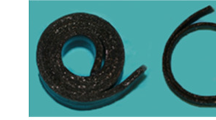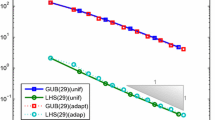Abstract
In this paper, we consider a number of optimal design problems for elastic bars and plates. The material characteristics of rigidity of an elastic nonhomogeneous medium are taken as the control variables. A linear functional of the solutions to the equilibrium boundary-value problem is minimized under additional restrictions upon the control variables.
Special variations of the control within a narrow strip provide a necessary condition for a strong local minimum (Weierstrass test). This necessary condition can be used for the detailed analysis of the following problems: bar of extremal torsional rigidity; optimal distribution of isotropic material with variable shear modulus within a plate; and optimal orientation of principal axes of elasticity in an orthotropic plate. For all of these cases, the stationary solutions violate the Weierstrass test and therefore are not optimal. This is because, in the course of the approximation of the optimal solution, the curve dividing zones occupied by materials with different rigidities displays rapid oscillations sweeping over a two-dimensional region. Within this region, the material behaves as a composite medium assembled of materials of the initial class.
Similar content being viewed by others
References
Klosowicz, B., andLurie, K. A.,On the Optimal Nonhomogeneity of a Torsional Elastic Bar, Archiwum Mechaniki Stosowanej, Vol. 24, No. 2, 1971.
Lurie, K. A.,Optimal Control in Problems of Mathematical Physics (in Russian), Nauka, Moscow, USSR, 1975.
Lurie, K. A., andCherkaev, A. V.,Prager Theorem's Application to the Optimal Design of Thin Plates (in Russian), Izvestija Akademii Nauk SSSR, Mekhanika Tverdogo Tela, Vol. 11, No. 6, 1976.
Lurie, K. A., andCherkaev, A. V.,Nonhomogeneous Bar of Extremal Torsional Rigidity (in Russian), Nonlinear Problems of Structural Mechanics, Optimal Design, Edited by V. N. Kisloskii Kiev Institute of Civil Engineers, Kiev, USSR, 1978.
Armand, J.-L.,Numerical Solutions in Optimization of Structural Elements, Paper Presented at the 1st International Conference on Computational Methods in Nonlinear Mechanics, Austin, Texas, 1974.
Olhoff, N.,Optimal Design of Vibrating Rectangular Plates, International Journal of Solids and Structures, Vol. 10, pp. 93–109, 1974.
Warga, J.,Optimal Control of Differential and Functional Equations, Academic Press, New York, New York, 1972.
Young, L. C.,Lectures on the Calculus of Variations and Optimal Control Theory, Saunders, Philadelphia, Pennsylvania, 1969.
Hill, R.,Elastic Properties of Reinforced Solids. Some Theoretical Principles, Journal of the Mechanics and Physics of Solids, Vol. 11, No. 5, 1963.
Bensoussan, A., Lions, J. L., andPapanicolaou, G.,Asymptotic Analysis for Periodic Structures, North Holland Publishing Company, Amsterdam, Holland, 1978.
Zhikov, V. V., Kozlov, S. M., Oleinik, O. A., andNgoan, K. T.,Homogenization and G-convergence of Differential Operators (in Russian), Uspekhi Matematicheskikh Nauk, Vol. 34, No. 5, 1979.
Lurie, K. A.,On the Optimal Distribution of Tensor of a Specific Resistance of the Working Fluid in a Channel of a MHD-generator (in Russian), Prikladnaja Matematika i Mekhanika, Vol. 34, No. 2, 1970.
Lions, J. I.,Controle Optimal de Systemes Gouvernés par des Equations aux Derivées Partielles, Dunod et Gauthier-Villars, Paris, France, 1968.
Tartar, L.,Problemes de Controle des Coefficients dans des Equations aux Derivées Partielles, Springer-Verlag, Berlin, Germany, pp. 420–426, 1975.
Raitum, U. E.,The Extension of Extremal Problems Connected with a Linear Elliptic Equation (in Russian), Doklady Akademii Nauk SSSR, Vol. 243, No. 2, 1978.
Olhoff, N., andCheng, K. T.,An Investigation Concerning Optimal Design of Solid Elastic Plates, Danish Center for Applied Mathematics and Mechanics, Report No. 174, 1980.
Raitum, U. E.,On Some Extremal Problems Connected with Linear Elliptic Equation (in Russian), Latviiskii Matematicheskii Ezhegodnik, Riga, USSR, 1968.
Litvinov, V. G.,Optimal Control of Coefficients in the Elliptic Systems (in Russian), Preprint No. 74.9 of the Institute of Mathematics, Academy of Sciences of the Ukrainian SSR, Kiev, USSR, 1979.
Litvinov, V. G.,The Problem of Optimal Control of the Fundamental Frequency of a Plate of Variable Thickness (in Russian), Zhurnal Vychislitel'noi Matematiki i Matematicheskoi Fiziki, Vol. 19, No. 4, 1979.
Ladyzhenskaya, O. A., andUraltseva, N. N.,Linear and Quasilinear Equations of Elliptic Type (in Russian), 2nd edition, Nauka, Moscow, 1973.
Cea, J., andMalanowski, K.,An Example of Min-Max Problem in Partial Differential Equations, SIAM Journal of Control, Vol. 8, No. 3, 1970.
Lekhnitzkii, S. G.,Anisotropic Plates (in Russian), Gostekhteoretizdat, Moscow, USSR, 1957.
Author information
Authors and Affiliations
Rights and permissions
About this article
Cite this article
Lurie, K.A., Cherkaev, A.V. & Fedorov, A.V. Regularization of optimal design problems for bars and plates, part 1. J Optim Theory Appl 37, 499–522 (1982). https://doi.org/10.1007/BF00934953
Issue Date:
DOI: https://doi.org/10.1007/BF00934953




